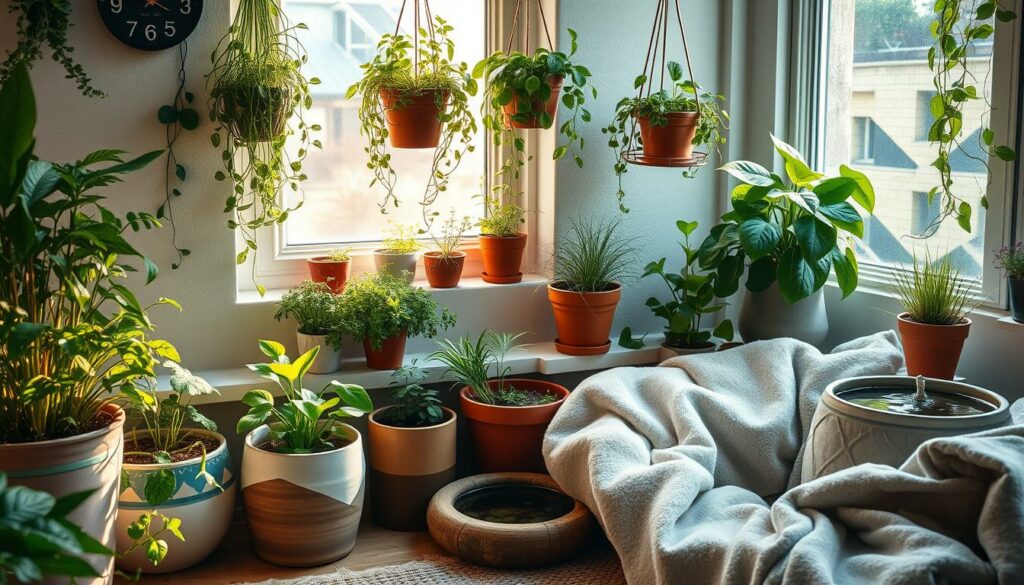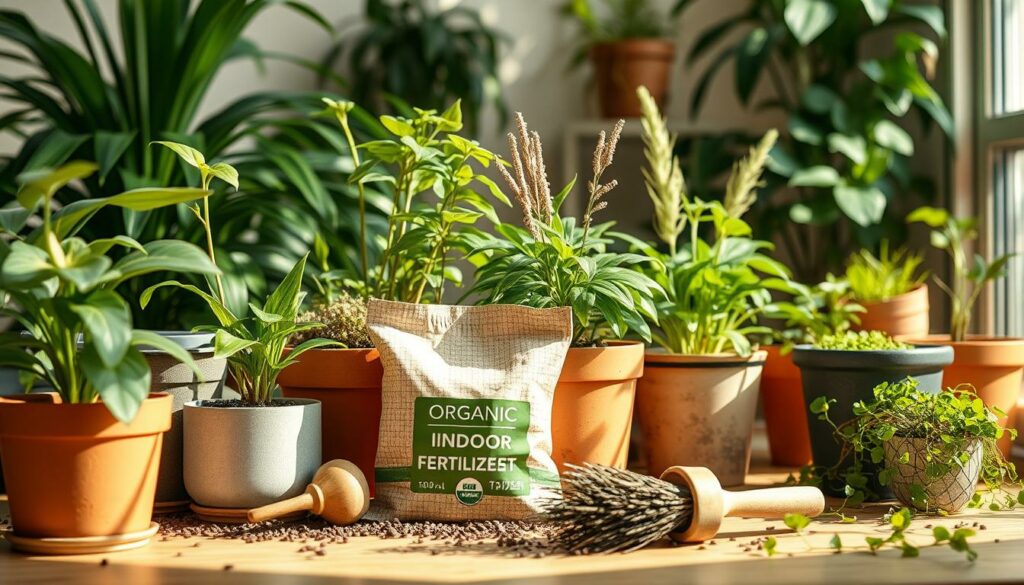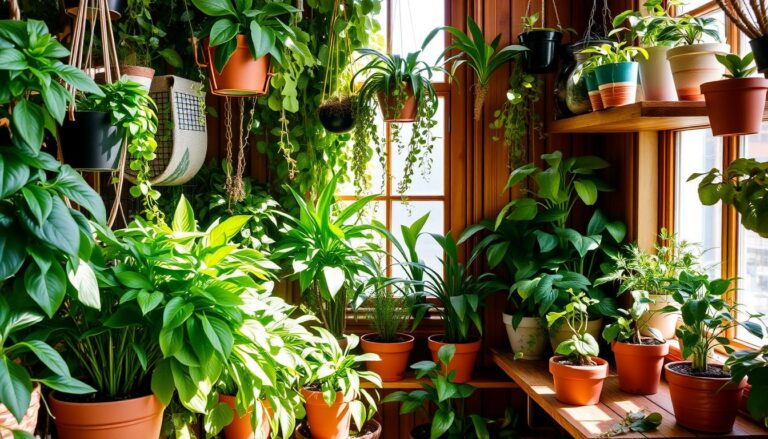As someone who loves indoor gardening, I often help beginners and seasoned gardeners. The secret to a successful indoor garden is knowing how to handle different factors. These include light, water, air, humidity, warmth, the right containers, and quality potting soil.
With the right knowledge, you can turn any small space into a lush oasis. It’s all about creating the perfect environment for your plants to flourish.
Key Takeaways
- Proper lighting is essential for plant growth, and understanding your indoor light conditions can help you choose the right plants or supplement with artificial lighting.
- Mastering watering techniques, including recognizing signs of over- or under-watering, is crucial for maintaining healthy plants.
- Ensuring adequate air circulation and controlling humidity levels can create an optimal environment for your indoor plants to thrive.
- Selecting the right containers with proper drainage and using high-quality potting mixes can support your plants’ root systems and overall health.
- Exploring indoor gardening techniques like hydroponics or vertical gardening can help you maximize your growing space and yield.
Understanding Light Requirements
Light is key for indoor plants to grow well. Plants use light to make food through photosynthesis. This process gives them the energy they need to live.
Importance of Light for Plant Growth
The light your plants get affects their growth. Different plants need different amounts of light. Some, like succulents, love bright sunlight. Others, like ferns, do better in less light.
Assessing Indoor Light Conditions
- Check your indoor light by looking at your windows and how much sunlight they get.
- South-facing windows give the most light, while north-facing windows get the least.
- Use a light meter or a phone app to measure light levels. This helps find the best spots for your plants.
Using Artificial Lighting for Plants
If your home doesn’t get enough natural light, use grow lights. These lights mimic sunlight for photosynthesis. They help plants grow well, even in dark spots.
| Light Requirement | Examples of Plants |
|---|---|
| High Light | Succulents, Cacti, Citrus Plants |
| Medium Light | Philodendrons, Pothos, Snake Plants |
| Low Light | ZZ Plants, Chinese Evergreens, Sansevieria |
“Proper lighting is the foundation for a thriving indoor garden. Understanding your space’s light requirements will help you select the right plants and create an environment where they can truly flourish.”
Mastering Watering Techniques
Watering is crucial for indoor gardening. It’s vital for a plant’s plant physiology. Water helps with structure, nutrient transport, and photosynthesis. Finding the right balance between overwatering and underwatering is essential for healthy plants.
Roles of Water in Plant Physiology
Water is key for nutrient absorption and transport in plants. It also helps control temperature and supports plant structure. Plus, it’s vital for photosynthesis, turning sunlight, carbon dioxide, and water into glucose.
Signs of Overwatering and Underwatering
- Overwatered plants show yellow leaves, wilting, and root rot.
- Underwatered plants are wilted, dried out, and may lose leaves.
It’s important to check soil moisture and adjust watering. This ensures the right balance for healthy, vibrant indoor plants.
“The key to successful indoor gardening is understanding the unique watering requirements of each plant and finding the right balance to support their growth and well-being.”
Maintaining Proper Air Circulation
Good air flow is key for indoor gardening. Plants need air to release water from their leaves. This helps them stay healthy and prevents mold and rot.
In indoor spaces, plants need fresh air. You can open windows or use fans for gentle air. This keeps your plants happy and healthy.
- Ensure adequate air flow around your indoor plants to support transpiration and prevent moisture buildup.
- Use fans or open windows to create gentle air movement, which can help prevent issues like mold and rot.
- Proper air circulation is a crucial, yet often overlooked, aspect of successful indoor gardening.
“Good air circulation is essential for the health and growth of indoor plants.”
Controlling Humidity Levels
Keeping the right humidity is key for your indoor plants’ health and growth. Many tropical plants love humid environments, with levels between 30-65%. But, it’s hard to keep this humidity, especially in dry places like homes during winter.
Ideal Humidity Range for Indoor Plants
The best humidity for most indoor plants is 30-65%. This helps them breathe and prevents problems like curled leaves or browning. Watch your plants’ humidity and adjust it to keep them happy and healthy.
Increasing Humidity for Tropical Plants
Tropical plants, like philodendrons, orchids, and ferns, need more moisture. Here are ways to add moisture:
- Regular misting: Spray your plants with a spray bottle to add moisture.
- Pebble trays: Put your plants on a tray with pebbles and water. The water will evaporate, raising the humidity.
- Humidifiers: Place a humidifier near your plants to increase the room’s humidity.
By watching humidity and using these methods, you can make a great home for your tropical plants.
| Plant Type | Ideal Humidity Range |
|---|---|
| Tropical Plants | 30-65% |
| Succulents and Cacti | 20-40% |
| Houseplants (general) | 40-60% |
Knowing your plants’ humidity needs and keeping it right can make your indoor garden thrive. It will show off the lush, vibrant growth of your tropical plants.
Providing Warmth for Plant Growth
Keeping the right plant warmth is key for your indoor garden to thrive. Some plants like cooler spots, but many tropical and subtropical ones need warmth to grow well. Temperature requirements are especially important for seeds to germinate and seedlings to grow.
To make sure your indoor plants get the warmth they need, follow these tips:
- Find out what temperature range your plants like. Tropical ones usually do best in 70-85°F (21-29°C). Some desert plants might like it a bit cooler.
- Use heaters like space heaters or heat mats to keep your plants warm. Make sure to adjust the temperature a bit lower at night.
- Insulate your growing area to keep the heat in and prevent sudden temperature changes. Seal any drafts and think about using thermal curtains or other insulation.
- Keep a close eye on the temperature and adjust it as needed. This ensures your plants get the temperature requirements they need to thrive.
“Providing the right temperature is just as important as meeting a plant’s light and water needs for optimal growth and development.”
By carefully controlling the plant warmth in your indoor garden, you can create a space that supports healthy growth and vibrant plants.
Choosing the Right Containers
The type of container you pick for indoor gardening is key to your plants’ health. It affects drainage and space for roots. The right container is essential for your plants’ success.
Importance of Drainage Holes
Drainage holes are crucial in container selection. They prevent root rot by letting water out. Containers need enough holes at the bottom for water to drain.
Selecting Container Size and Material
The container size should match the plant’s root system. Choose one that’s a bit bigger than the plant’s current size. This allows for growth. The material, like plastic or terracotta, affects water retention and air flow.
| Container Material | Advantages | Disadvantages |
|---|---|---|
| Plastic | Lightweight, durable, and inexpensive | May not allow for adequate air flow around roots |
| Terracotta | Porous material allows for air circulation, absorbs excess moisture | Can be more fragile and expensive than other options |
| Ceramic | Variety of designs and styles, good insulation properties | Heavier than other materials, can be more expensive |
Think carefully about container selection, drainage, container size, and container material. This will help your indoor plants thrive.

Using Quality Potting Mixes
For indoor gardening, the potting mix quality is as important as the container. Garden soil is too dense for indoor plants. Instead, use a high-quality, well-draining mix made for indoor use.
These mixes are lighter and full of nutrients. They help plants grow well in small spaces. Using a quality potting mix ensures your plants thrive, no matter the container size.
Look for these key ingredients in a good potting mix:
- Garden soil for a solid foundation
- Perlite or other materials for excellent drainage
- A blend of peat moss and compost to retain moisture
Some gardeners also use coir or PitMoss to make custom mixes. Understanding soil quality is key to growing healthy indoor plants. It sets the stage for a successful gardening experience indoors.
| Ingredient | Purpose |
|---|---|
| Garden Soil | Provides a solid foundation and nutrient content |
| Perlite | Improves drainage and aeration |
| Peat Moss | Retains moisture and helps prevent compaction |
| Compost | Adds organic matter and additional nutrients |
“The quality of the potting mix is just as important as the container you choose for your indoor plants. Don’t skimp on this essential ingredient for their success.”
Indoor Gardening Techniques
There are many new ways to grow plants indoors, beyond just using soil. Hydroponics and soilless systems let you grow plants in water, not soil. These methods are great for growing food like leafy greens and herbs indoors.
Hydroponics and Soilless Growing Systems
Hydroponics grows plants in water full of nutrients, without soil. This indoor gardening technique helps plants grow faster and yields more. It also lets you control the environment better. Other systems like aeroponics and aquaponics are also popular for growing plants indoors.
Vertical Gardening and Space-Saving Strategies
Vertical gardening and saving space are also key for indoor gardening techniques. Using hanging baskets, tiered shelves, or wall planters makes the most of small indoor spaces. This way, you can grow many different plants, even in a small area.
| Indoor Gardening Technique | Description | Key Benefits |
|---|---|---|
| Hydroponics | Growing plants in nutrient-rich water, without soil | Faster growth, higher yields, precise environmental control |
| Soilless Systems | Aeroponics, aquaponics, and other soil-free methods | Efficient resource use, compact footprint, adaptable to indoor spaces |
| Vertical Gardening | Using hanging baskets, tiered shelves, or wall-mounted planters | Maximizes limited indoor space, allows for a wider variety of plants |

“By embracing innovative indoor gardening techniques like hydroponics, soilless systems, and vertical gardening, urban dwellers can transform even the smallest of spaces into thriving, productive gardens.”
Pest Management for Indoor Plants
Keeping an indoor garden healthy is rewarding, but pests can still attack. Common pests include aphids, mealybugs, spider mites, and fungus. Watching your plants closely and preventing pests can help.
Healthy plants are less likely to get pests. Make sure they get enough light, water, and nutrients. Check your plants often for signs of pests like damage or insects.
- Use a gentle stream of water to wash off and dislodge pests from the leaves and stems of your plants.
- Manually remove any visible insects or egg masses, using a cotton swab dipped in rubbing alcohol or a mild insecticidal soap.
- Consider introducing beneficial insects, such as ladybugs or lacewings, to your indoor garden to help control common pests naturally.
If pests keep coming back, you might need organic pesticides. Always follow the product’s instructions and protect yourself and your plants.
| Pest | Identification | Organic Control Methods |
|---|---|---|
| Aphids | Small, soft-bodied insects that come in a variety of colors, including green, black, and red. | Wash plants with a strong stream of water, use insecticidal soap, or introduce ladybugs. |
| Mealybugs | White, cotton-like insects that cluster on stems and leaves. | Wipe down plants with a cotton swab dipped in rubbing alcohol, or use neem oil. |
| Spider Mites | Tiny, spider-like pests that spin fine webs on the underside of leaves. | Mist plants regularly, introduce predatory mites, or use insecticidal soap. |
| Fungus Gnats | Small, dark-colored flies that are attracted to moist soil and fungus. | Allow soil to dry out between waterings, use yellow sticky traps, or apply beneficial nematodes. |
By being careful, taking steps to prevent pests, and acting fast when you see them, you can keep your indoor garden healthy. This way, you can enjoy a pest-free indoor garden.
Fertilizing Indoor Plants
Proper nutrition is key for your indoor plants’ health. Containers quickly use up soil nutrients. So, you need to add a balanced fertilizer made for indoor plants. Use a liquid or slow-release fertilizer regularly to give plants the nutrients they need, like nitrogen, phosphorus, and potassium.
Watching and adjusting your indoor plant fertilizer schedule is important. This ensures your indoor garden stays lush and productive. Knowing about plant nutrition helps you give the right nutrients for growth and performance.
Choosing the Right Fertilizer
When picking an indoor plant fertilizer, choose one for container plants. These fertilizers have less nitrogen to prevent too much leaf growth. They also release nutrients slowly. Consider the nutrient ratio, type of formula, ingredients, and micronutrients when choosing.
- Nutrient ratio (NPK value)
- Slow-release or water-soluble formula
- Organic or synthetic ingredients
- Micronutrient content
Applying Fertilizer Properly
Follow the package instructions for how much and how often to apply. Usually, use a diluted liquid fertilizer every two to four weeks. Or, use a slow-release granular formula for months of steady nutrients. Don’t over-fertilize to avoid plant stress and soil salt buildup.
| Fertilizer Type | Advantages | Disadvantages |
|---|---|---|
| Liquid Fertilizer | Rapid nutrient absorption, easy to apply | Requires more frequent application |
| Slow-Release Fertilizer | Provides a steady supply of nutrients, less frequent application | May take longer to see results |
| Organic Fertilizer | Gentle on plant roots, promotes healthy soil | May not provide immediate results |
By knowing your indoor plants’ plant nutrition needs and using the right indoor plant fertilizer at the right time, you can keep your indoor garden thriving. This brings beauty and life to your home.

Best Plants for Indoor Gardening
When setting up your indoor garden, picking the right plants is key. Look for low-light plants and edible plants that do well indoors.
Low-Light Tolerant Plants
Many houseplants can handle the little sunlight indoors. Here are some great options:
- Snake plants (Sansevieria): These tough succulents handle low light well.
- ZZ plants (Zamioculcas zamiifolia): They’re strong and don’t need much care.
- Philodendrons: These vines add greenery and are easy to care for.
- Chinese Evergreen (Aglaonema): They have beautiful leaves and like shade.
- Cast Iron Plant (Aspidistra): These plants are hardy and don’t need much light.
Edible Plants for Indoor Growing
If you want to grow your own food, there are many edible plants for indoors. Here are some good choices:
- Leafy greens: Lettuce, spinach, and kale grow well indoors.
- Herbs: Basil, mint, and thyme are great for cooking and grow well indoors.
- Microgreens: These small greens are packed with nutrients and can be grown all year.
- Compact vegetables: Small tomatoes, peppers, and eggplants can grow well in containers.
| Plant Type | Light Requirements | Watering Needs | Potential Challenges |
|---|---|---|---|
| Snake Plant | Low to medium light | Infrequent watering | Susceptible to overwatering |
| Lettuce | Partial shade to bright light | Consistent moisture | Bolting in hot conditions |
| Basil | Bright, direct light | Moderate, regular watering | Prone to pests and diseases |
Choosing the right best indoor plants, low-light plants, and edible indoor plants is crucial. This way, you can have a thriving indoor garden that brings nature’s beauty and bounty into your home.
“The secret to successful indoor gardening is understanding the light, water, and humidity needs of your plants.”
Conclusion
Understanding the needs of indoor plants is key to a thriving garden, even in small spaces. The right indoor gardening techniques are essential. Light, water, air, humidity, and temperature all matter for plant health.
Choosing the right containers, potting mixes, and nutrients is also important. Plus, keeping pests away helps your plants grow well. With the right care, you can enjoy fresh greenery all year, in your own home.
Whether you’re new to indoor gardening or experienced, learning to care for plants can make your home a peaceful oasis. It’s rewarding to nurture your own indoor garden.
FAQ
What are the key factors to consider when growing plants indoors?
Why is light so critical for indoor plant health and growth?
How can you ensure proper watering for indoor plants?
Why is air circulation important for indoor plants?
How can you maintain the ideal humidity levels for indoor plants?
What temperature range is best for indoor plants?
What factors should you consider when choosing containers for indoor plants?
Why is the quality of potting mix important for indoor plants?
What are some innovative indoor gardening techniques?
How can you manage pests in an indoor garden?
How should you fertilize indoor plants?
What types of plants are best suited for indoor gardening?
Source Links
- Growing plants indoors: A beginner’s guide — HOMESTEAD BROOKLYN – https://homesteadbrooklyn.com/all/2017/1/21/growing-plants-indoors-a-beginners-guide
- 9 Tips for Indoor Vegetable Gardening | Bonnie Plants – https://bonnieplants.com/blogs/garden-fundamentals/indoor-vegetable-gardening
- A Beginner’s Guide to Indoor Gardening Like a Pro – https://www.architecturaldigest.com/story/beginners-guide-to-indoor-gardening
- Growing Bonsai: Tips for Miniature Tree Enthusiasts
- Buying Bonsai: Tips for Selecting Your Perfect Tree
- Bonsai Potting: Essential Tips for Tree Care Success
- Bonsai Maintenance: Essential Care for Tiny Trees
- Mastering the Art of Shaping Bonsai: A Beginner’s Guide


